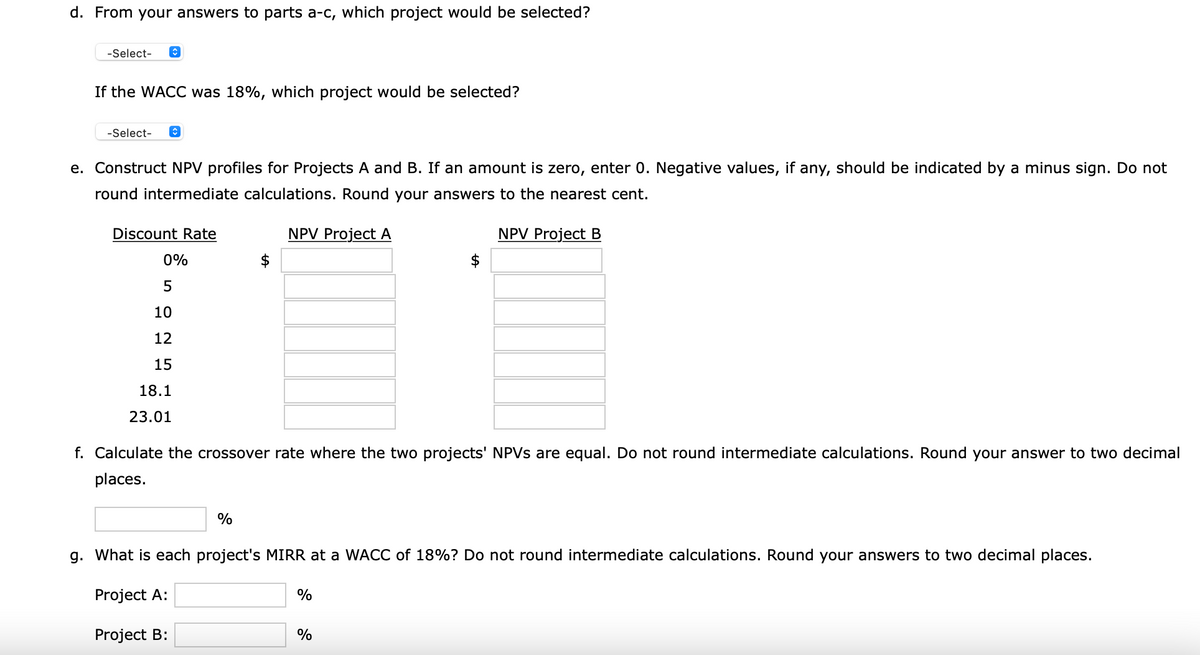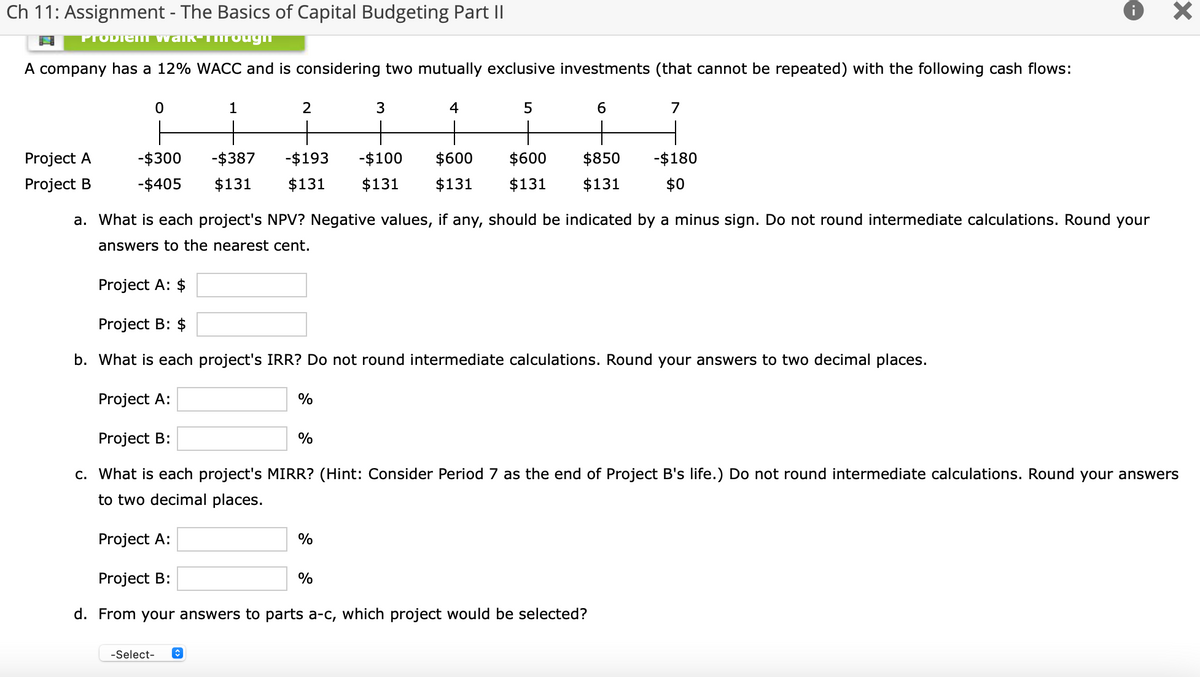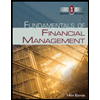d. From your answers to parts a-c, which project would be selected? -Select- If the WACC was 18%, which project would be selected? -Select- e. Construct NPV profiles for Projects A and B. If an amount is zero, enter 0. Negative values, if any, should be indicated by a minus sign. Do not round intermediate calculations. Round your answers to the nearest cent. Discount Rate NPV Project A NPV Project B 0% $ 2$ 10 12 15 18.1 23.01 f. Calculate the crossover rate where the two projects' NPVS are equal. Do not round intermediate calculations. Round your answer to two decimal places. %
d. From your answers to parts a-c, which project would be selected? -Select- If the WACC was 18%, which project would be selected? -Select- e. Construct NPV profiles for Projects A and B. If an amount is zero, enter 0. Negative values, if any, should be indicated by a minus sign. Do not round intermediate calculations. Round your answers to the nearest cent. Discount Rate NPV Project A NPV Project B 0% $ 2$ 10 12 15 18.1 23.01 f. Calculate the crossover rate where the two projects' NPVS are equal. Do not round intermediate calculations. Round your answer to two decimal places. %
Fundamentals of Financial Management, Concise Edition (MindTap Course List)
9th Edition
ISBN:9781305635937
Author:Eugene F. Brigham, Joel F. Houston
Publisher:Eugene F. Brigham, Joel F. Houston
Chapter12: Cash Flow Estimation And Risk Analysis
Section: Chapter Questions
Problem 18P: OPTIMAL CAPITAL BUDGET Hampton Manufacturing estimates that its WACC is 125%. The company is...
Related questions
Question
D, E, F, G, need to be solved

Transcribed Image Text:d. From your answers to parts a-c, which project would be selected?
-Select-
If the WACC was 18%, which project would be selected?
-Select-
e. Construct NPV profiles for Projects A and B. If an amount is zero, enter 0. Negative values, if any, should be indicated by a minus sign. Do not
round intermediate calculations. Round your answers to the nearest cent.
Discount Rate
NPV Project A
NPV Project B
0%
5
10
12
15
18.1
23.01
f. Calculate the crossover rate where the two projects' NPVS are equal. Do not round intermediate calculations. Round your answer to two decimal
places.
%
g. What is each project's MIRR at a WACC of 18%? Do not round intermediate calculations. Round your answers to two decimal places.
Project A:
Project B:
%

Transcribed Image Text:Ch 11: Assignment - The Basics of Capital Budgeting Part II
PTODIEM Vwalk-Tirougn
A company has a 12% WACC and is considering two mutually exclusive investments (that cannot be repeated) with the following cash flows:
1
3
4
6.
7
Project A
-$300
-$387
-$193
-$100
$600
$600
$850
-$180
Project B
-$405
$131
$131
$131
$131
$131
$131
$0
a. What is each project's NPV? Negative values, if any, should be indicated by a minus sign. Do not round intermediate calculations. Round your
answers to the nearest cent.
Project A: $
Project B: $
b. What is each project's IRR? Do not round intermediate calculations. Round your answers to two decimal places.
Project A:
%
Project B:
c. What is each project's MIRR? (Hint: Consider Period 7 as the end of Project B's life.) Do not round intermediate calculations. Round your answers
to two decimal places.
Project A:
%
Project B:
%
d. From your answers to parts a-c, which project would be selected?
-Select-
Expert Solution
This question has been solved!
Explore an expertly crafted, step-by-step solution for a thorough understanding of key concepts.
This is a popular solution!
Trending now
This is a popular solution!
Step by step
Solved in 5 steps with 6 images

Knowledge Booster
Learn more about
Need a deep-dive on the concept behind this application? Look no further. Learn more about this topic, finance and related others by exploring similar questions and additional content below.Recommended textbooks for you

Fundamentals of Financial Management, Concise Edi…
Finance
ISBN:
9781305635937
Author:
Eugene F. Brigham, Joel F. Houston
Publisher:
Cengage Learning

Fundamentals of Financial Management, Concise Edi…
Finance
ISBN:
9781285065137
Author:
Eugene F. Brigham, Joel F. Houston
Publisher:
Cengage Learning

Fundamentals Of Financial Management, Concise Edi…
Finance
ISBN:
9781337902571
Author:
Eugene F. Brigham, Joel F. Houston
Publisher:
Cengage Learning

Fundamentals of Financial Management, Concise Edi…
Finance
ISBN:
9781305635937
Author:
Eugene F. Brigham, Joel F. Houston
Publisher:
Cengage Learning

Fundamentals of Financial Management, Concise Edi…
Finance
ISBN:
9781285065137
Author:
Eugene F. Brigham, Joel F. Houston
Publisher:
Cengage Learning

Fundamentals Of Financial Management, Concise Edi…
Finance
ISBN:
9781337902571
Author:
Eugene F. Brigham, Joel F. Houston
Publisher:
Cengage Learning

Fundamentals of Financial Management (MindTap Cou…
Finance
ISBN:
9781337395250
Author:
Eugene F. Brigham, Joel F. Houston
Publisher:
Cengage Learning

Fundamentals of Financial Management (MindTap Cou…
Finance
ISBN:
9781285867977
Author:
Eugene F. Brigham, Joel F. Houston
Publisher:
Cengage Learning

Accounting (Text Only)
Accounting
ISBN:
9781285743615
Author:
Carl Warren, James M. Reeve, Jonathan Duchac
Publisher:
Cengage Learning